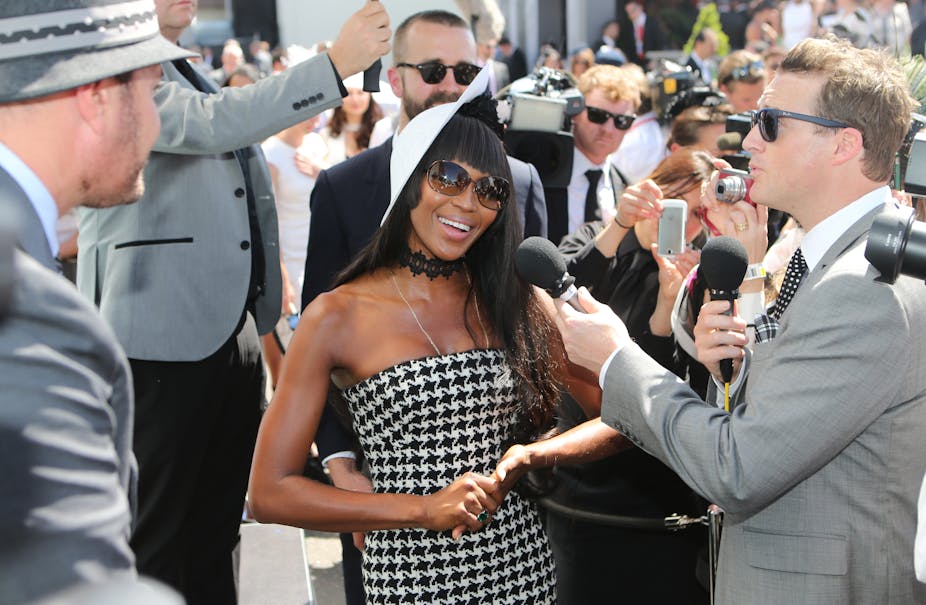Women, fashion, and glamour are synonymous in the modern era – but in the mid to late 1980s this association intensified into one distinct cultural icon: the supermodel.
While highly professional models with identifiable looks and personalities had existed since the 1950s, (Christian Dior’s favourite was called Lucky) and celebrity models since the 1960s (think Twiggy), the 1980s version literally superseded their predecessors in stature, stardom, and – most importantly – earning capacity.
The supermodels were an elite and exclusive group. Key figures included Americans Cindy Crawford and Christy Turlington, Brit Naomi Campbell, Canadian-born Linda Evangelista and Claudia Schiffer from Germany.
This grouping is not definitive and the term was applied to other high profile models of this generation including Australia’s own Elle “The Body” Macpherson and later notably English model Kate Moss. A list of very specific characteristics secured the pedigree of the original supermodels.

First, self evidently, perhaps were their physical attributes. While each supermodel had a distinct “look” (Linda’s old world glamour versus Cindy’s girl-next-door) all of them had bodies of Amazonian proportions. Strong and lean as opposed to slim and diminutive they embodied a powerful, intense and indeed mythical vision of female beauty.

Second, as at home on the catwalk as they were in editorials, a supermodel was a supermodel simply by virtue of her market value. Witness Linda’s quip to journalist Jonathan Van Meter:
We don’t wake up for less than $10,000 a day.
Finally real supermodels managed to transcend the world of fashion that had borne them and registered simply as celebrities with all that entailed, including dating movie stars, hosting TV shows, and becoming fodder for gossip magazines.
The precise cultural circumstances that saw the celebrity cachet of models arise are difficult to discern but it is clear that a number of factors aligned.

Big name celebrity designers such as Versace and Karl Lagerfeld became the figureheads for global conglomerate fashion, the worlds of entertainment and fashion merged through internationalised media networks, and, in Paris, John Casablancas of Elite Model Management championed a new brasher version of the modelling agency.
One of Casablancas’ key strategies entailed marketing his “girls” as a group. This ploy dovetailed nicely with a genre of fashion photography that had been developed in the 1950s – the large cast fashion shoot.
Throughout the 1980s and early 1990s high-end fashion photographers including Peter Lindbergh, Steven Meisel and Herb Ritts developed compelling editorial spreads that featured groupings of supermodels lined up next to each other wearing variations on a theme. In these somewhat disarming images each model seems to trump the beauty of the next resulting in a giddying excess of glamour.
The supermodels faced the 1990s optimistically appearing en masse on the covers of the world’s most influential fashion magazines and attracting lucrative make-up endorsements. But meanwhile the fashion clock was ticking. Not only was grunge replacing glamour as the fashionable ideal the whole image of the supermodel with her perfect beauty was attracting critique from various quarters.

Despite the fact these women were without exception naturally beautiful they became emblematic of an idea of falseness and artifice often associated with fashion. Moreover the fact that they traded on their appearance, and made previously unheard of amounts of money for merely “being beautiful” was frequently interpreted as morally corrupt.
Finally and most ironically, as the “reality” of their lives was exposed through increased media exposure (failed marriages, bungled career moves, and the like) their very humanity seemed to work against them.

The real treachery however came from within the industry.
In the March 1996 edition of US Vogue, an article entitled “Supermodels, the Sequel” was busy promoting four new younger “faces” who were keen to distance themselves from their slightly more experienced counterparts.
While all the interviewees agreed that the supermodels had played an important role in the industry (from which they now profited) none of them wanted to be associated with prima donna behaviour or vacuous self promotion. Aligning themselves instead with notions of reality and groundedness, there was a sense they wouldn’t let the market value of their beauty go to their heads.
For me perhaps the clearest sign that the reign of the supermodel was well and truly over was when Anita Roddick, founder of The Body Shop, launched the highly successful “honest advertising” campaign in 1998 with the byline:
There are 3 billion women who don’t look like supermodels and only 8 who do.

While the campaign won widespread support and turned Broddick’s fortunes around, I find it unfortunate that its logic comes at the cost of ostensibly pitching eight of the world’s successful and beautiful women against the rest.
Read more articles in The Story Of series

